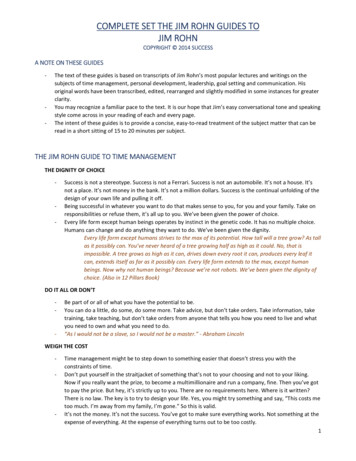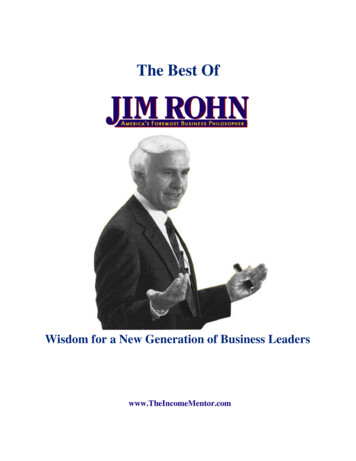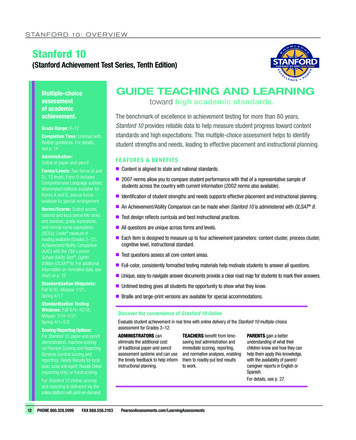
Transcription
Leadership Jim Rohn’sTenth Pillar of Success:Part Three 2010 Jim Rohn InternationalOne-Year Success Plan559
Week 42Welcome to Week 42 of The Jim Rohn One-Year Success Plan. We hope you are having a great weekand are ready for this week’s journey.How necessary is it to identify and develop leaders in your organization? As we have discussed thismonth, leadership goes way beyond just holding a position. Leadership is the ability to influenceothers, and I might add the word positively. To positively influence others, whether at work, amongpeers or at home, the ability to have a positive influence on those around you is a goal that we allshould embrace.Great leaders are able to identify and gather upcoming leaders on an ongoing basis. In athletics,a wise coach wants to make sure his top players have bought into his system, because the topplayers have the greatest influence on the rest of the team. In fact, if you look at most of the greatchampionship teams, you will see great leadership among the top players. For the Los Angeles Lakersit was Magic Johnson, for the Chicago Bulls it was Michael Jordan, Bird for the Celtics, Staubach for theCowboys, and Gretzky for the Oilers—you get the picture. When the coach has his best players 100percent committed to winning and to his system, he has his top players literally influencing the rest ofthe team.If you have an organization that is waning, where should you begin? Find your Michael Jordan, theperson who has the heart and desire to succeed and who can set an example for the rest of the group.It’s called positive peer pressure—leadership designed to lead others into a more positive experienceand growth opportunities.So, whether you are leading or following, step up to the challenge of helping create positive peerpressure (influence) in your organization, group, team or home.Make it a great week!Kyle Wilson“Respect is the key determinant of highperformance leadership. How muchpeople respect you determines how wellthey perform.”560 One-Year Success Plan—Brian Tracy 2010 Jim Rohn International
LeadershipJim Rohn’s Tenth pillar of success: Leadership,Part Three—skills needed for effective leadership anddeveloping potential leaders in your organizationHello, Jim Rohn here. Remember our key phrase this month: You are a leader! Continue to grow inyour leadership position so that you can effectively lead the group around you, no matter what size it is!1. The Foundational Principles of Leadership and Developing a Powerful Vision. Two weeksago, we covered the basic foundational elements that are central to becoming a person withtremendous leadership skills and abilities. We discussed the secrets to having a powerful andcompelling vision that helps you attract others.2. Character: The Core of Leadership and Leadership Mistakes to Avoid. Last week we lookedat what I believe is the core element of what it means to be a leader: the issue of character.We looked at what it means to be a person of character who can lead others forward, and howcharacter is essential in successfully leading others. We also looked at some typical leadershipmistakes people make that hinder their ability to lead and move their organizations forward, and welearned how you can avoid making those same mistakes.3. Skills Needed for Effective Leadership and Developing Other Leaders in YourOrganization. This week we will turn our eyes away from the character traits of leaders and lookmore at the basic skills that effective leaders demonstrate. We will look at some strategic ways todevelop other leaders around you to ensure a new generation of leaders.4. Becoming the Best Leader You Can Be—Taking Care of Yourself as the Leader andMotivating Those Who Follow You—in Good Times and Tough Times. Next week, we will takea closer look at making sure that you take care of yourself. In this day and age, it is even moreimportant for the leader to closely guard their personal growth and development. We will also lookat how to motivate others to follow you.Last week we talked about how character is the core of great leadership. Secondary to character are aleader’s skills. A person with strong character still needs the skills to get the job done. And the higherthe leadership responsibility, the better the skills must be. Below are what I consider to be the primaryskills that every leader should master (or begin to master as you grow in your leadership). Commityourself to work on these, and you will see your leadership and influence grow as well.First, why is skill development important? Here are a few major reasons:Leadership is the challenge to be something more than average, and that requires developing our skills.Skill development is important in and of itself, if for no other reason than the fact that as humans, wewere designed to grow. Life is a journey, and we reflect the purpose of the Master Planner by going asfar down that road as we can, developing our skills to make ourselves better.Skill development is important because it brings us fulfillment. As we grow in our skills, we develop adeep sense of personal satisfaction knowing we have learned something new, and that not only did welearn it, but we also applied it successfully.Skill development is important because it will advance our career. As much as many modern-day peoplewould like to believe that there shouldn’t be competition, there always will be. And, believe it or not,the winner is usually the person who has honed their skills. Be it on the field or in the boardroom, thewinner is usually the person with the higher level of skills. 2010 Jim Rohn InternationalOne-Year Success Plan561
Week 42Skill development will help you help others, and this is what life is all about, isn’t it? One of the thingsa skilled leader can do is to help people see themselves better than they are. And I think that goeshand in hand with what Zig Ziglar says, “You can get everything you want out of life if you help othersget what they want out of life.” What comes around goes around. You reap what you sow. Howeveryou say it, when you develop skills, you are able to help others, and that helps you in the long run.Now, let’s talk about the skills great leaders must master:The Ability to be Inspirational. A leader needs to be able to inspire others. Yes, we need to hitthe mind with our message, but we also need to stir the heart and its passions. The leader who isonly rational will have bored followers who aren’t inspired to go anywhere. The leader who is onlyemotional will have excited followers who do not know where to go! It takes both. Develop your abilityto inspire your followers and make them excited to be with you and the organization. Help them seethe big picture that shows they are making a difference.Good Communication—Especially Vision. Great leaders are those who can take the vision theyhave and communicate it in ways that their followers can easily understand, internalize and own. Manyleaders have great vision but fail to lead their organizations anywhere. Vision that is only kept in yourmind is not vision, but a dream. Vision communicated clearly, memorably and passionately, so thatpeople can grasp it and follow, is what will take your group, whether large or small, to the next leveland beyond.The Ability and Will to Delegate. Great leaders know that they cannot do it all on their own. Theymay be able to do a lot on their own, but they will never achieve the powerful impact that is possibleuntil they learn to delegate, and then choose to do so. There is an old proverb that says, “One can put1,000 to flight and two can put 10,000 to flight.” When we delegate to capable people, we increaseour effectiveness and impact exponentially. Unfortunately, too many leaders do not attain greatnessbecause they refuse to let anyone else do anything. Learn to delegate—to the right people—and youwill be moving in the right direction.The Ability to Teach Important Principles. When you look at great leaders in history, you seemen and women who are able to teach. Christ, the greatest leader in history (his organization thrivesin every country 2,000 years after his death), primarily led people by teaching them with stories. Heknew that he would have to transfer concepts to his followers that they could remember and apply. Infact, they called him “teacher.” A good example of a modern-day business leader who used teaching isJack Welch at General Electric. When Welch began leading GE, it had a market cap of 4 billion. Beforehe retired, it had reached as high as 400 billion. Now, that is a return! And what was at the core ofhis leadership? Teaching. GE had its own university long before it was vogue for companies to do so.He knew that people needed to be taught, and Welch spent many hours teaching there himself.The Ability to Set Goals, Strategies and a Course of Action. The leader is responsible for a few keyareas. Vision is one, and we have discussed that. The leader is also responsible for setting the goals ofthe organization. They must determine (with the help of others) what the team will shoot for. They needto be big enough to stretch the followers, but realistic enough so as not to discourage them. The leadermust also set strategy, again, with the help of others. When they see where the organization must go,they must also plot the map to get there, at least in a big-picture sense. Managers can take care of therest, but the leader is responsible for giving the general strategic direction. Lastly, the leader must setthe course of action, defining behaviors of the organization that will be acted upon. Setting the goals willgive your team what it needs to shoot for, defining the strategy will show them how to get there, andsetting the course of action will show them what to do while carrying out the strategy.562 One-Year Success Plan 2010 Jim Rohn International
Keep People Focused on the Goal. Followers operate on a day-to-day basis. They get tasks donethat need to be done for that day or week, or even quarter. Leaders are different. They are big-picturepeople. They know that the organization will outlive them, and because of that, the perspective must befor the good of the organization, not just the individuals. They must see where the end is. The Japanesebusiness community is renowned for setting 100-year goals. We Americans think 20-year goals arelooking to the future, and they are, but 100-year goals? Incredible. So, leadership involves not onlysetting a course for today, but also further into the future. Skilled leaders have learned not only howto inspire those following to catch avision and pursue it, but they’ve alsolearned how to paint a vivid pictureof the results that will continue tomotivate them to accomplish thegoals of the organization, long afterthey are gone. And when they havecreated a beginning and defined theend, then they are ready to plot theroad between.Remember, you can always increaseyour skills. Even if you just increasethem a little bit, you will increaseyour effectiveness and your impactsignificantly. Even the smallest ofchange in a trajectory will mean a largechange in distance.Next, Chris will talk to you about how tomultiply leadership in your organization,with an emphasis on what to look for infuture leaders.Until next week, let’s do somethingremarkable!Jim Rohn“As a leader, you should always start withwhere people are before you try to takethem to where you want them to go.” 2010 Jim Rohn International—Jim RohnOne-Year Success Plan563
Week 42Hi there, Chris Widener here. This week I want to talk with you about how to multiply leadership inyour organization and what to look for in future leaders.Extraordinary leaders are those who understand that in order for the organization to grow and makeits maximum impact, the leadership base in the organization must grow first and grow strong enoughto hold the growth. If this does not happen, the organization will either not grow or will grow and thencrumble because there is no solid foundation of leadership. The effort to multiply leadership must beongoing and purposeful. Here are some ways to get your leadership base growing strong and wide!1. G et Current Titled Leaders Growing in the Right Direction. If you want to increase the level andeffectiveness of your leadership right now, then the first thing you should do is start with those whoalready have a title of leadership. You may find that many of the people appointed as “leaders” arenot effective leaders, and as a result, you may have your work cut out for you! Sit down with yourleadership team and let them know that you will be encouraging them to grow in their leadership skills.It is imperative that the titled leaders get onboard. If they don’t, or won’t, then decisions of leadershipchange may have to be made so that the forward motion of your organization can progress.2. Establish a Plan of Action for Leadership Development. Once you have decided to moveforward with leadership development, you need a plan. I would suggest a one-year plan of readingand activities. Currently, I am taking a group of 17 people through a 12-month (one meeting permonth) plan of leadership development. Each person must read the required book for the month.Each person takes responsibility in a given area. Each person gives a verbal presentation to the restof the group on an aspect of leadership. They are accountable to another person in the group fortheir development. This is the plan of action. If you need help setting up a plan like this, feel free tocontact me and I will help.3. Identify Untitled Leaders. You also want to identify the leaders you have who may not necessarilyhave a title of leadership. Know this, though: They are leading! They are influencing the direction ofyour company or organization. They are leading and influencing others. Find out who they are andinvite them into the official leadership process. How do you find them? Here are a few ways: Notice atyour
Jim Rohn’s TenTh pillaR of success: leadeRship, paRT ThRee—skills needed foR effecTive leadeRship and developing poTenTial leadeRs in youR oRganizaTion H ello, Jim Rohn here. Remember our key phrase this month: You are a leader! Continue to grow in your leadership position so that you can effectively lead the group around you, no matter what size it is! 1. The foundational principles of .











